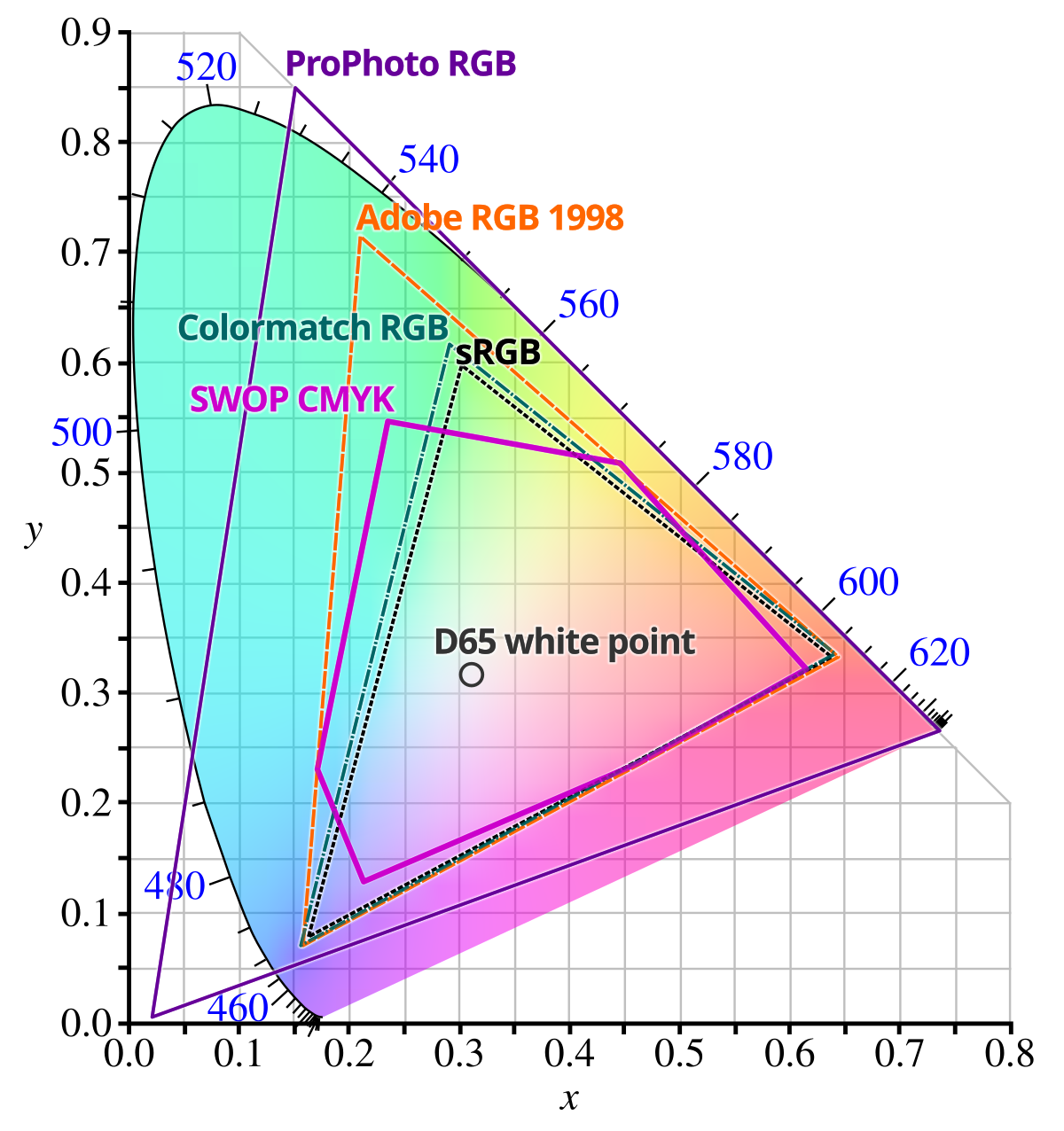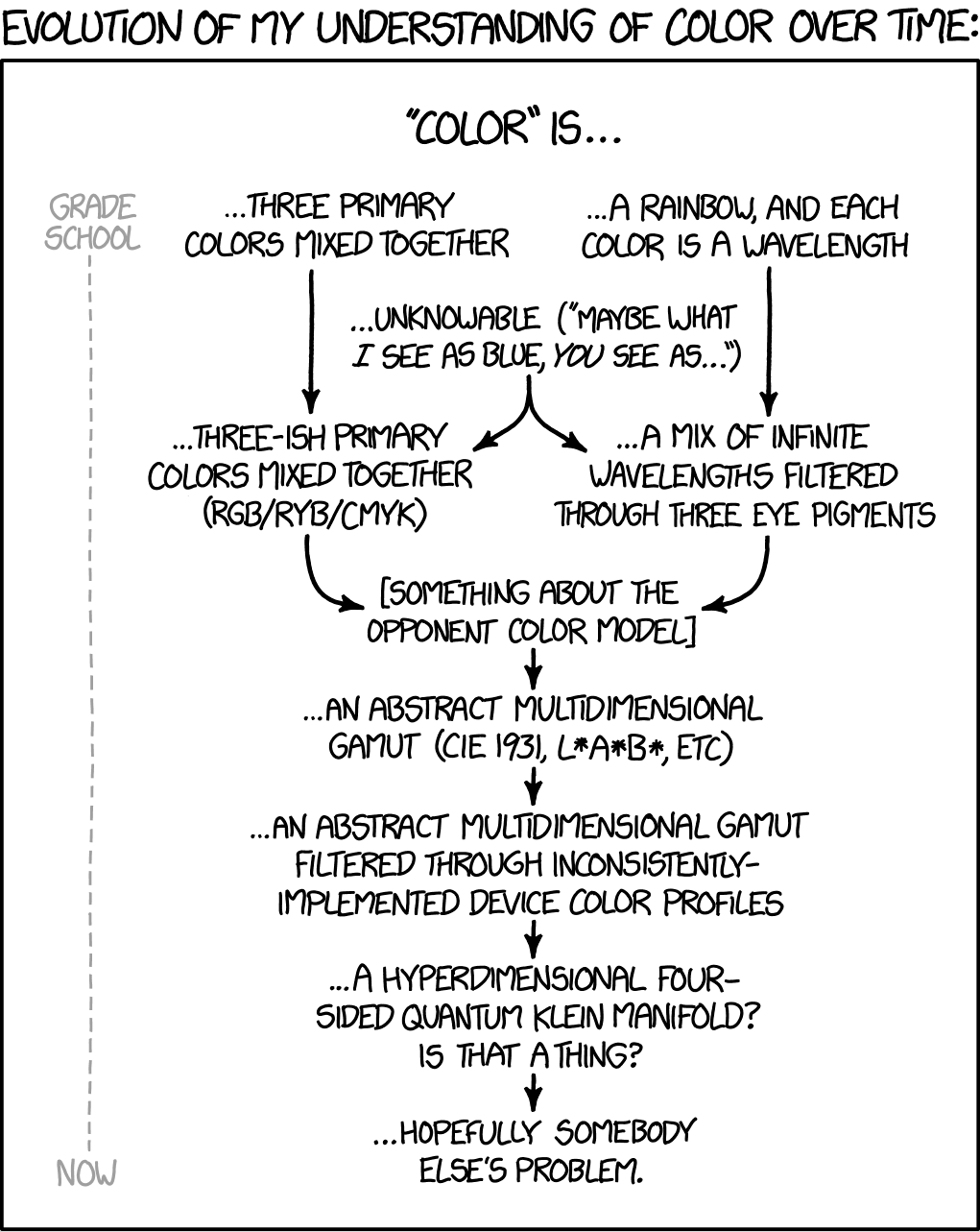Unreal claims concerning purple
-
I’ve encountered a lot of crap recently about how “purple isn’t real” or “purple is an illusion” or “you can’t actually see purple.” I was aware of this, uh, “subculture” before, but it’s only in the past few months or so that I’ve somewhat-regularly seen this idea supported in my own life. Anyone else experienced something similar?
It’s so suddenly pervasive, in fact, that I’m fully expecting someone here to pipe up in support… let’s start with an explanation of how purple is any different from, say, orange or grey, and go from there.
On an entirely unrelated note, here’s an empirical approximation of the appearance of 420 nm light.

-
Purple isn't real. It's just a bunch of those electromagnetic things. Ever seen those? Yeah, well there you go. Even the eggheads can't agree whether those are waves or particles, what a pile of horseshit.
Filed under: Ever had to clean out leftover photons from your dust filters? No? Clearly not particles.
-
@kazitor not sure which subcultures you are in, but I never heard about this particular idea before. Sounds stupid though.
On the other hand, I have heard people say that about pink.
-
Purple only exists as a combined light of red and blue, as there is no single (lightwave) frequency which would exite both red and blue cones in our eyes.
-
@Flips said in Unreal claims concerning purple:
Purple only exists as a combined light of red and blue, as there is no single (lightwave) frequency which would exite both red and blue cones in our eyes.
Meaning it is indeed “different” from orange, but not from grey or anything else that’s not a single frequency.
INB4 white isn’t a color.
-
Called it!
@Flips said in Unreal claims concerning purple:
Purple only exists as a combined light of red and blue
@kazitor said in Unreal claims concerning purple:
On an entirely unrelated note, here’s an empirical approximation of the appearance of 420 nm light.

C'monnnn, the least you could do is offer something beyond the pre-emptive canned responses!
I shan’t address the issue of “red” and “blue” cones for now… but it leads nicely into what I think allows these crazy colour ideas to spread. To properly explain even the most basic aspect of colour vision requires a stupid amount of background and nuance. So things like “purple isn’t real” can take hold because you just throw a few simple, easy-to-grasp ideas around (“there’s no single wavelength, ooOOooOoOo, everyone knows the purpose of colour vision is to identify monochromatic lights that only exist in lasers!”) and it sounds convincing because nobody has the time to seek out and read a thorough treatment of the topic.
So what I’m hearing here is:
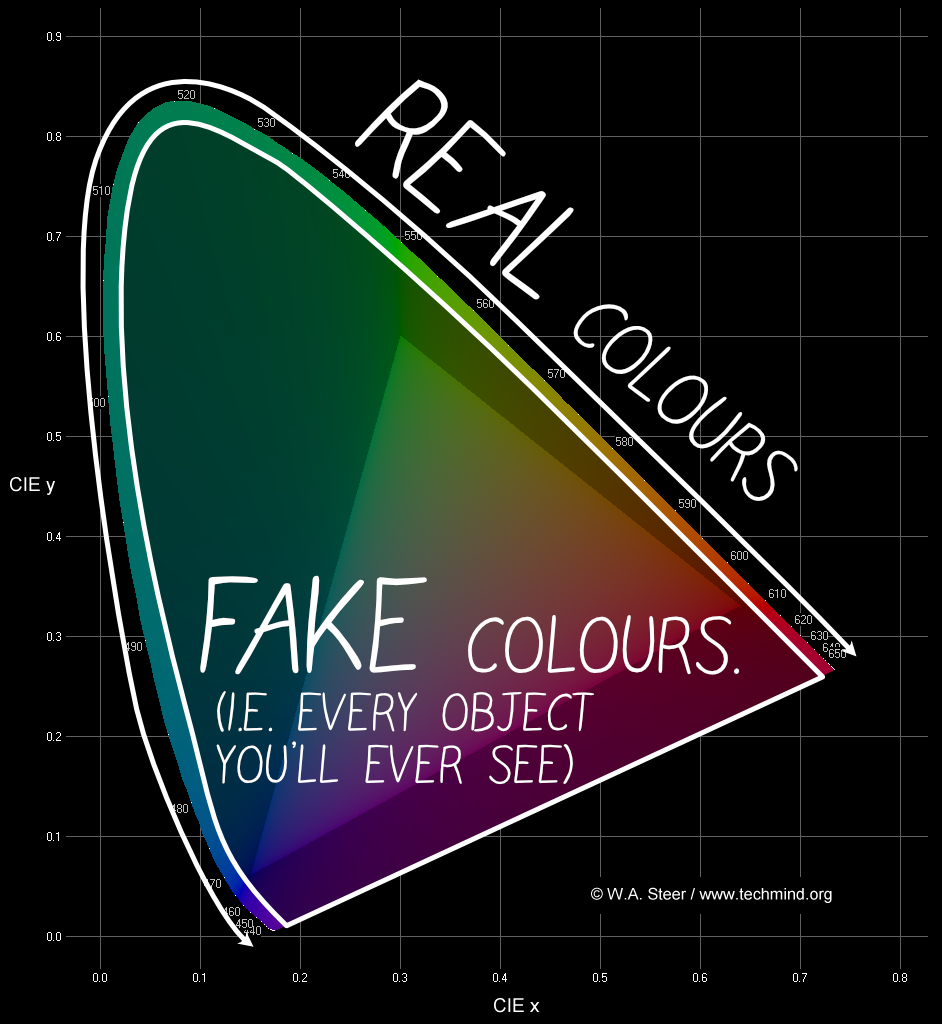
Filed under: yeah I have a chip on my shoulder
-
@kazitor said in Unreal claims concerning purple:
On an entirely unrelated note, here’s an empirical approximation of the appearance of 420 nm light.

That's clearly a gold dress.
-
@kazitor said in Unreal claims concerning purple:
Called it!
@Flips said in Unreal claims concerning purple:
Purple only exists as a combined light of red and blue
@kazitor said in Unreal claims concerning purple:
On an entirely unrelated note, here’s an empirical approximation of the appearance of 420 nm light.

C'monnnn, the least you could do is offer something beyond the pre-emptive canned responses!
I still don't understand why the unrelated note about some violet will help us identify a purple

ps About your infographic; Every object can only have real colors. But when emitted these colors get interfered with, which shapes them into fake colors. This will be true for 100% of light we experience on a daily basis.
-
I heard this about magenta, from seemingly reputable sources.
(Mentioned briefly in the opening.)
-
@error said in Unreal claims concerning purple:
[...]
It seems there are multiple sets of imaginary colors, dependent on the source and target.
Your article talks about the hyperbolic colors, but starts off with a composite of all colors (white) instead of the opposite color only (as appearing in wiki's infographic).
Most interesting for me is the stygian set of colors. You superimpose color on an image where color is 100% absent, which is in line with the article: Our visual state gets saturated and continues to send signals, after the visual input has stopped.
-
Purple is real, Brown isn't.
-
Paging @Tsaukpaetra, our resident Unreal expert.
E:
 while I was deliberating if this is funny and got distracted.
while I was deliberating if this is funny and got distracted.
-
@kazitor said in Unreal claims concerning purple:
So things like “purple isn’t real” can take hold because you just throw a few simple, easy-to-grasp ideas around (“there’s no single wavelength, ooOOooOoOo, everyone knows the purpose of colour vision is to identify monochromatic lights that only exist in lasers!”) and it sounds convincing because nobody has the time to seek out and read a thorough treatment of the topic.
It's like those mathematical "proofs" that have a division by zero hiding somewhere.
-
@Flips said in Unreal claims concerning purple:
there is no single (lightwave) frequency which would exite both red and blue cones in our eyes
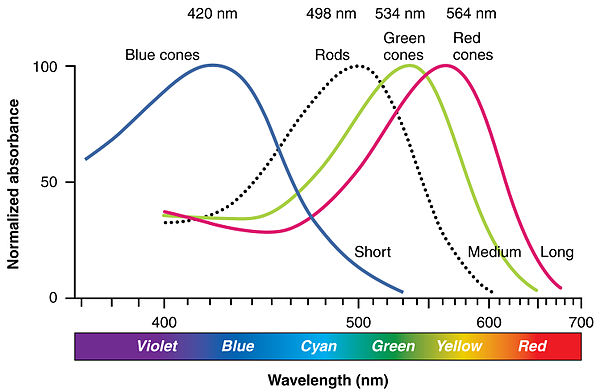
-
I'm quite fond of the colour purple however when we get into puce and mauve terrority then i know you're making shit up.
-
@DogsB said in Unreal claims concerning purple:
I'm quite fond of the colour purple
Agreed, I thought Whoopi Goldberg was very good in it.
-
@dkf said in Unreal claims concerning purple:
@Flips said in Unreal claims concerning purple:
there is no single (lightwave) frequency which would exite both red and blue cones in our eyes

So, where is the purple?
-
@kazitor said in Unreal claims concerning purple:
I’ve encountered a lot of crap recently about how “purple isn’t real” or “purple is an illusion” or “you can’t actually see purple.” I was aware of this, uh, “subculture” before, but it’s only in the past few months or so that I’ve somewhat-regularly seen this idea supported in my own life. Anyone else experienced something similar?
It’s so suddenly pervasive, in fact, that I’m fully expecting someone here to pipe up in support… let’s start with an explanation of how purple is any different from, say, orange or grey, and go from there.
On an entirely unrelated note, here’s an empirical approximation of the appearance of 420 nm light.

As purple hair enthusiast, and Prince fan, I find this extremely offensive.
-
@robo2 said in Unreal claims concerning purple:
@kazitor not sure which subcultures you are in, but I never heard about this particular idea before. Sounds stupid though.
On the other hand, I have heard people say that about pink.Pink is really just light red. We don't have a special color for light blue or light yellow.
Though, I hate red and pink together.
-
@Gurth said in Unreal claims concerning purple:
@DogsB said in Unreal claims concerning purple:
I'm quite fond of the colour purple
Agreed, I thought Whoopi Goldberg was very good in it.
Did they translate it to UK English?
-
I guess the problem boils down to whether "a real colour" is
- a tristimulus / a point in a colour space (with a separate holy war on which colour space represents "real" colours), i.e. something that happens in the head, with @kazitor supporting this point in the CIE XYZ colour space
- a single wavelength, which seems to be the point preferred by @Flips
- the spectrum (as a real-valued function of wavelength) of visible-range electromagnetic radiation emitted, reflected or transmitted by an object that reaches the observer in a given point in space, which is the definition that some spectroscopists I know like the most
- something else
-
@aitap As with any multiple-choice question posed on TDWTF, the answer is, "Yes."
whether "a real colour" is a misspelling of "color"

-
-
@aitap Color is a perceptual quantity and has no one-to-one mapping to wavelength. The latter is quite important, especially when it comes to modern technology. If colors and wavelengths were one-to-one, constructing full color screens would be much more difficult (and it's quite unlikely that we would have them). Talking about color as a single wavelength doesn't make much sense. I'm not sure why one color would be more real than another.
-
Is purple a color? Let’s ask the phone:

Guess that’s settled.
-
@aitap said in Unreal claims concerning purple:
with a separate holy war on which colour space represents "real" colours
I’m not aware of this having ever been a point of contention… all colour spaces are transformations of each other; they all represent (subsets of) the same set of perceptions so any is just as real as another? CIE XYZ is pretty irrelevant here, it’s simply that
- I had a diagram handy

- the chromaticity diagram ignores luminosity
- XYZ encompasses spectral colours
Regarding colour as a spectral power distribution – if you work in spectrometry all the time it makes sense to use a simple term for the subject matter, but it shouldn’t be conflated with colour as actually seen. As cvi said, colour is a human perception. It derives from EMR but ultimately has very little to do with it. It’s fully possible for stimuli with the same colour to have quite different spectral power distributions – when was the last time you looked at a fluorescent lighting and saw the peaks of mercury vapour with your own eyes? Key point: spectra have effectively infinite dimensions while colour is reduced to three.
And lastly, that only monochromatic light can be called real – that means there are real purples, but literally every object you ever see is fake. Which is all just… silly? What does “fake colour” even practically mean if you still see it just the same?
- I had a diagram handy
-
@cvi, @kazitor, thanks for clarifying your viewpoints! As a matter of fact, I do agree that colours are perceptual.
@kazitor said in Unreal claims concerning purple:
I’m not aware of this having ever been a point of contention…
I agree that this is probably not as important, but, for example, these people insisted on using CAM02-UCS colour space instead of, say, CIE-LUV when creating their palettes, because theirs was "more perceptual" (oversimplification).
when was the last time you looked at a fluorescent lighting and saw the peaks of mercury vapour with your own eyes?
I thought they were in the UV and therefore absorbed and reemitted by the fluorescent material at different wavelengths?
-
@aitap Not entirely in the UV; there are lines in the visible spectrum, too:

-
@Flips Purple is defined as RGB
#800080, which isXYZ(29.6438, 14.242, 48.47805). Taking into account the XYZ colour matching functions, one of the possible purples could look like this: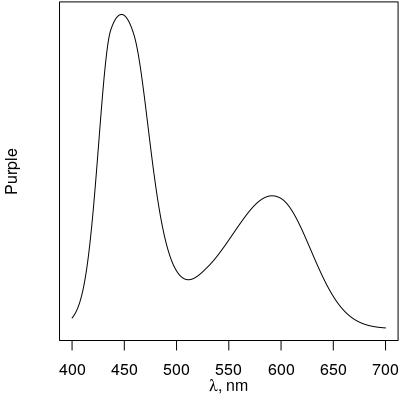
It is indistinguishable for humans from any other power distribution spectrum that gives the same values for
∫P(λ)x(λ)dλ,∫P(λ)y(λ)dλ,∫P(λ)z(λ)dλ.
-
@HardwareGeek Thanks!

mouth.insert(foot)
-
Schrödinger's Color: are these Ticket to Ride cards Pink or Purple?

(I like to call it pinkle.)
-
@Karla said in Unreal claims concerning purple:
@Gurth said in Unreal claims concerning purple:
@DogsB said in Unreal claims concerning purple:
I'm quite fond of the colour purple
Agreed, I thought Whoopi Goldberg was very good in it.
Did they translate it to UK English?
Yeah, it’s a kind of a reverse of The Madness of George III.
-
@aitap said in Unreal claims concerning purple:
As a matter of fact, I do agree that colours are perceptual.
-
@aitap said in Unreal claims concerning purple:
I guess the problem boils down to whether "a real colour" is
- a tristimulus / a point in a colour space (with a separate holy war on which colour space represents "real" colours), i.e. something that happens in the head, with @kazitor supporting this point in the CIE XYZ colour space
- a single wavelength, which seems to be the point preferred by @Flips
- the spectrum (as a real-valued function of wavelength) of visible-range electromagnetic radiation emitted, reflected or transmitted by an object that reaches the observer in a given point in space, which is the definition that some spectroscopists I know like the most
- something else
But no sir. I do view the complete spectrum as real color space. But that complete spectrum, did not come from 1 source, so it would be a mistake to think, that there exist objects who emit more then 1 frequency at the same time. A spectrum is more like a statistical analysis on a group of said objects.
But my point is:
When you see light, you can't determine the constituent frequencies based on how you perceive the color of that light. There seem to be multiple ways to 'construct light' which look the same but have different properties.
And apparently this phenomenon is basis to discerning real (natural) colors, and that imaginary family of purples, as those fakey ones are not represented on the spectrum, only in our brain.Come to think of it.. It's actually the same as the black/white discussion.
Flips retroactively upvotes all previous posts
-
@Flips said in Unreal claims concerning purple:
But that complete spectrum, did not come from 1 source, so it would be a mistake to think, that there exist objects who emit more then 1 frequency at the same time.
Monochromatic light is rather the exception than the rule. Black body radiation (=sunlight) is full-spectrum. Most materials have more than one absorption/emission line. LEDs/Lasers are the exception here, where the emitted light is often quite narrow-band (though it's possible to construct LEDs that have multiple or even wide emission bands).
The question becomes how you'd even define "1 frequency". Take something like an Na-lamp (Sodium vapour lamp). These are often considered to be monochromatic, but they actually emit at two distinct frequencies, 589nm ad 589.56nm. And both of those peaks also have a certain width.
-
@cvi said in Unreal claims concerning purple:
That is not the only setup, just the most common one. And where colourblind people don't have one of the cone types, there are also mutations where people have additional types of cones for wide colour perception (up to 5 types, I think).
-
@aitap said in Unreal claims concerning purple:
I agree that this is probably not as important, but, for example, these people insisted on using CAM02-UCS colour space instead of, say, CIE-LUV when creating their palettes, because theirs was "more perceptual" (oversimplification).
Color spaces have different kind of differences. (Ugh, I hate that sentence, but bear with me.)
RGB is largely unspecified. There is no single RGB space. This is why we have stuff like sRGB or Adobe-RGB. None of these cover the full space of colors that we can perceive. This is what diagrams such as the following try to show:
The RGB spaces result in triangles (each corner is one of red, green or blue, respectively). They can represent the colors that are covered by the triangle. (There are some additional properties to the different spaces, so sRGB includes a transfer function that is primarily useful when working with 8bit per-channel values. As a consequence, sRGB is non-linear and one shouldn't do computations in that space).
Something like CIELUV and variants (CIE something or other) are more focused on the perceptual stuff than RGB. Specifically CIELUV and CIELAB (fuck typing those asterisks) try to have a perceptually uniform distribution. So if you have the same euclidean distance between two sets of points, the perceived difference between the sets of points should be roughly equal. This is a pretty empiric definition; IIRC, they actually made random people stare at different colors and noted down what those people said they perceived.
Something like HSV or HSL typically has a one-to-one mapping with RGB, so it's just an alternative representation of the same space. This also means that there technically are multiple different HSV/HSL spaces (like RGB). IME, the alternative representations are useful for manipulating colors (V or L is tied to the lightness, S is saturation and H is hue -- you can play around with those).
YUV and YIQ are mainly used in video/image encoding/compression. Y is luminance, and somewhat similar to V or L in HS[VL]. UV and IQ are not very intuitive but encode color information. The main realization here is that humans perceive luminance/lightness at a much higher resolution than color. Meaning that you can store Y at the full resolution, and the color information at a lower one (half / quarter are typical). That obviously reduces the amount of data (whether or not that's a good idea depends on what you're trying to do with the images).
-
@PleegWat said in Unreal claims concerning purple:
And where colourblind people don't have one of the cone types, there are also mutations where people have additional types of cones for wide colour perception (up to 5 types, I think).
Yeah.
In fact, the most common variation being three different kinds of color receptors (R, G and B) is quite a shitty decision. Having two or four would have been much better. Now we have to deal with the fact that a pixel is something with a factor of three, which fucks with memory alignment everywhere.

-
@error_bot xkcd 1882
-
-
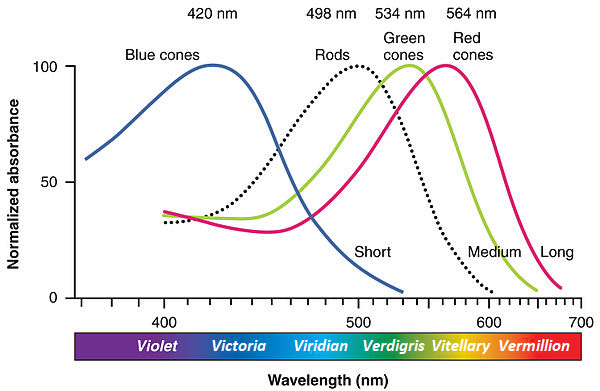
FTFV
-
@hungrier V is thankful.

-
As a color disabled persin I find this topic very triggering
-
@cvi said in Unreal claims concerning purple:
two distinct frequencies, 589nm ad 589.56nm
 Those are wavelengths, not frequencies.
Those are wavelengths, not frequencies.They correspond to two distinct frequencies of 508.99 THz and 508.50 THz, respectively, but the values you stated are wavelengths.
-
@cvi said in Unreal claims concerning purple:
The RGB spaces result in triangles (each corner is one of red, green or blue, respectively). They can represent the colors that are covered by the triangle.
One could replace the RGB emitters with something like RGCV and get a quadrilateral that would more completely cover the perceptible gamut, but obviously more complicated and probably far too late to get any traction in the industry.
-
@aitap said in Unreal claims concerning purple:
@HardwareGeek Thanks!

mouth.insert(foot)You're not entirely wrong. Some of the emission spectrum is in the UV, including one line that is very bright, and this is primarily responsible for inducing the fluorescence, but there is some visible (and IR), too.
-
@Karla said in Unreal claims concerning purple:
We don't have a special color for light blue
I'm pretty sure Russians disagree with you on that.
-
@cvi said in Unreal claims concerning purple:
@Flips said in Unreal claims concerning purple:
But that complete spectrum, did not come from 1 source, so it would be a mistake to think, that there exist objects who emit more then 1 frequency at the same time.
Monochromatic light is rather the exception than the rule.
When it reaches your eye? yes. When it's produced, no.
Black body radiation (=sunlight) is full-spectrum. Most materials have more than one absorption/emission line.
But only when you bombard them with energy.
LEDs/Lasers are the exception here, where the emitted light is often quite narrow-band (though it's possible to construct LEDs that have multiple or even wide emission bands).
The question becomes how you'd even define "1 frequency". Take something like an Na-lamp (Sodium vapour lamp). These are often considered to be monochromatic, but they actually emit at two distinct frequencies, 589nm ad 589.56nm. And both of those peaks also have a certain width.
defining it is easier then observing it. Take your lamp:
Power goes in. Light, heat, friction, chemical reactions, come out.
Which (concrete) processes are there, and which are responsible for which frequency?When we argue for a 100% isolated case (a LED on steroids), we maybe can conclude that for some power supply over x time, all energy went in the process exiting 1 or multiple electrons, and all energy came out in the form of light with the same amount of energy (hence, all light had the same frequency, regardless of empirical measurement-variances).
-
@Flips well, a simple Fourier transform shows that no source of finite duration can be truly monochromatic. Any finite pulse has a non zero spread in frequency.
Like frictionless bearings, massless, unstretchable strings, and massless, linear springs, "monochromatic" light only exists in physics utopia. All real light sources have some finite, non-zero bandwidth. Yes, even single atom emission spectra. That's guaranteed by the uncertainty principle (which when applied to massless particles basically just restates the nature of a Fourier transform). Often that bandwidth is narrower than we care about, so we call it a single frequency. But it fundamentally isn't. Only spectra exist.
-
@Flips said in Unreal claims concerning purple:
When it's produced, no.
No, when it's produced too. Black body radiation is (as mentioned) broad-spectrum. It's the number one source of light (mainly because the sun outshines everything else by unfunny amounts).
If you're talking about singular photons, the first part of your statements makes no sense. Singular photons have a single wavelength/frequency, so they will be single wavelength when they reach our eyes as well.
When we argue for a 100% isolated case (a LED on steroids), we maybe can conclude that for some power supply over x time, all energy went in the process exiting 1 or multiple electrons, and all energy came out in the form of light with the same amount of energy (hence, all light had the same frequency, regardless of empirical measurement-variances).
(a) What @Benjamin-Hall said. (b) There are always minor variations to everything in the real world. Even in a perfect system, you still have to deal with uncertainty. In a real-world system, you additionally have all sorts of noise (thermal, ...). This isn't a measurement variance; "imperfect" measurements just add on top.

 Photoreceptor cell - Wikipedia
Photoreceptor cell - Wikipedia
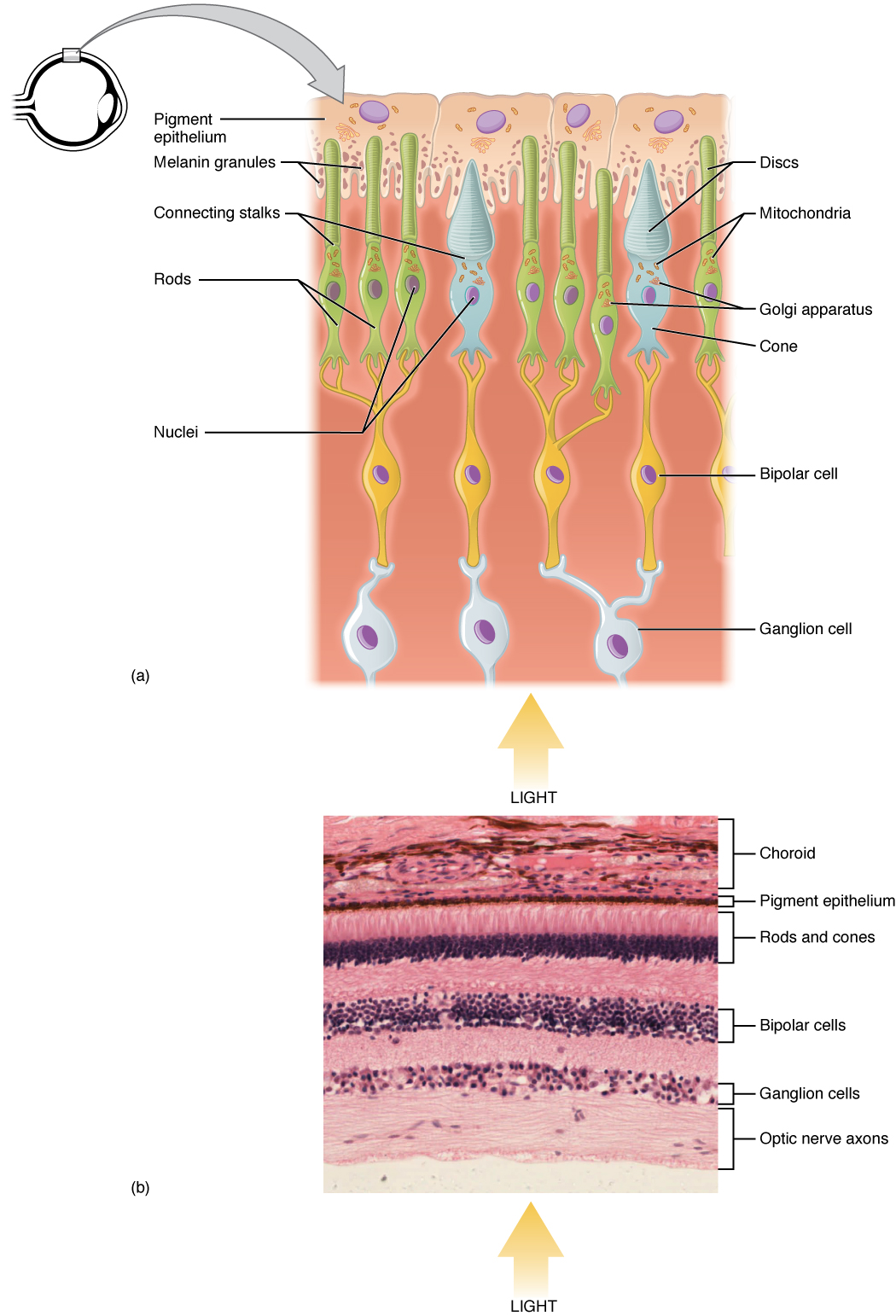
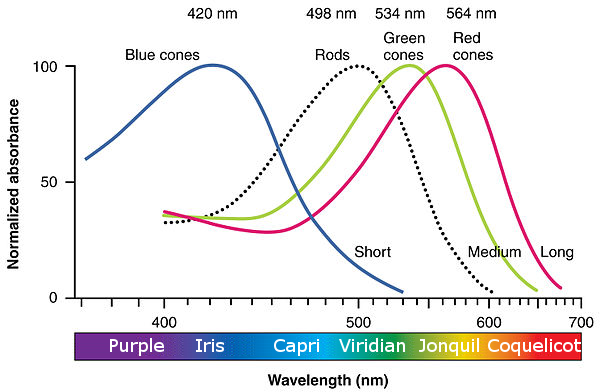
 File:CIE1931xy gamut comparison.svg - Wikimedia Commons
File:CIE1931xy gamut comparison.svg - Wikimedia Commons
